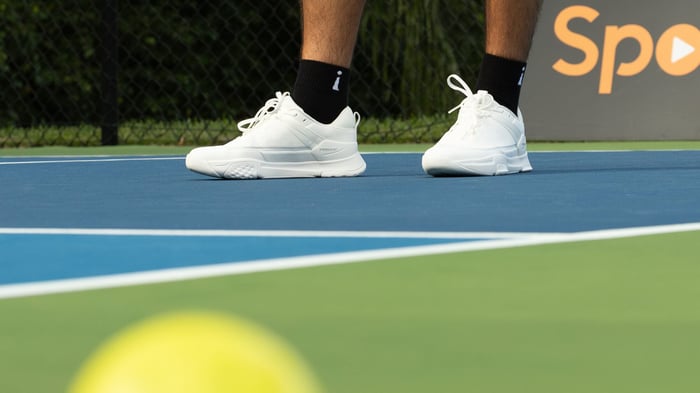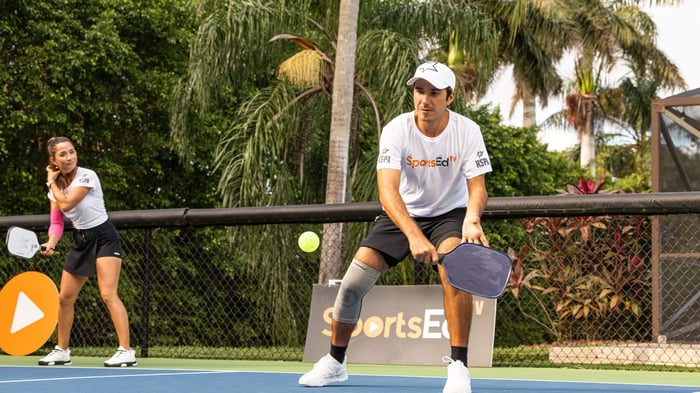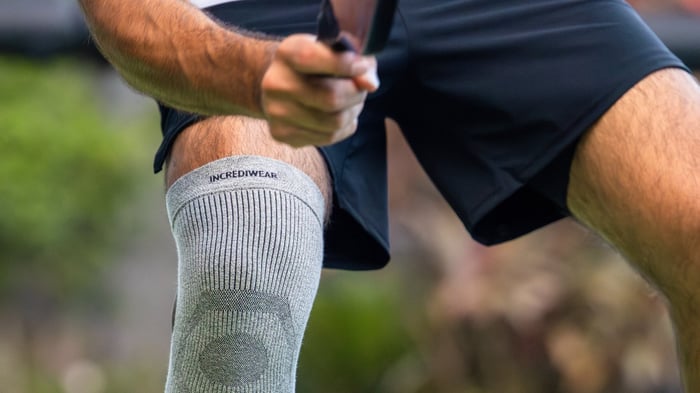Key takeaways:
Structured practice routines that combine skill-building drills, fitness exercises, and tactical awareness are essential for measurable improvement in pickleball.
Performance-ready apparel and court shoes designed for lateral movement enhance training effectiveness and support peak performance during intense drills.
Consistency and variety in practice routines prevent skill plateaus, build muscle memory, and keep players mentally engaged while addressing weaknesses.
While casual players might hit balls randomly for an hour, competitive athletes follow structured pickleball practice routines that target specific skills with laser focus. Top competitors dedicate 45 minutes to an hour per session, working through strategic drills that build everything from dinking precision to mental toughness under pressure, especially when they have the right foundation supporting every movement.
This focused approach to training makes all the difference between good and great. The most successful players understand that intentional practice challenges every aspect of their game, and strategic training methods combined with skill drills and mental preparation lead to faster improvement. Performance-ready apparel and court shoes designed for quick lateral movements can make the difference between executing a perfect third shot drop and missing it wide.
Ready to discover which specific routines the pros use to dominate their competition?
What makes an effective pickleball practice routine?
Training sessions that actually work go beyond simply hitting balls for an hour. The most productive routines blend three core components: skill-building drills that target specific techniques, fitness elements that build the physical foundation for peak performance, and tactical awareness exercises that sharpen decision-making under pressure.
Structured routines with dynamic warm-ups, targeted drills, and game simulations create measurable improvements in your game. A balanced approach should include agility, endurance, strength, speed, and flexibility exercises that directly support your on-court performance.
While regular practice sessions prevent skill plateaus and build muscle memory, introducing new challenges and drill variations keeps your mind engaged and your opponents guessing. Consistent practice helps players avoid plateaus and achieve measurable improvements in their game, but the key lies in harder drills and different skill challenges. Smart players rotate through different drill types weekly, ensuring they address weaknesses while maintaining their strengths.
Beyond training methodology, the physical foundation matters just as much. Effective pickleball routines start with what you wear and how you perform on the court. Performance-ready apparel that wicks moisture and allows a full range of motion keeps you comfortable through intense drilling sessions, while court shoes designed for lateral movement and quick pivots directly impact your ability to execute every drill with precision.
Start strong with dynamic pickleball warm-up exercises
Smart players know that preparation makes the difference between good practice and great practice. Dynamic warm-ups raise your body temperature and prime muscles for the explosive actions pickleball demands, while static stretching before play can actually decrease strength and power output.
Arm circles and shoulder rolls - Perform forward and backward circles to activate shoulder joints and ready them for overhead shots and serves.
Lateral lunges with reach - Step wide to each side while reaching across your body to mimic the lateral motions and stretches you'll use during competitive play.
Leg swings and high knees - Swing each leg forward and backward, then march in place with high knees to loosen hip joints and engage your core.
Torso twists with paddle - Hold your paddle and rotate your torso side to side to condition your spine for cross-court shots and quick reactions.
Butt kicks and quick feet - Jog in place while kicking heels to glutes, then practice quick lateral steps to prime your body for explosive actions at the net.
Wrist circles and grip activation - Rotate your wrists in both directions and practice controlled paddle grips with varying pressure to condition these critical joints for repetitive paddle work and maintain consistent grip strength throughout long practice sessions.
Master movement with targeted footwork drills for pickleball
Championship-level shot execution starts with your feet. Solid footwork creates the stable platform needed for consistent performance and allows you to cover more court area effectively, leading to more winning points. When your positioning is off by even six inches, your paddle angle changes, your balance shifts, and what should be a controlled dink becomes an easy put-away for your opponent. Driven players understand that mastering movement patterns builds the foundation that separates reactive players from those who control the pace and positioning of rallies.
The most effective footwork drills for pickleball target the lateral shuffles and rapid direction changes that define competitive play.
Lateral shuffle drills with markers placed five feet apart train your body to maintain proper knee bend while moving side to side, mimicking the exact movements needed to reach wide shots.
Forward and backward sprint patterns between markers ten feet apart condition your legs for explosive transitions between offensive attacks and defensive retreats that happen dozens of times per match.
Balance exercises that require practicing paddle swings while standing on one leg simulate the unstable conditions you face during intense rallies, building the core stability that keeps your shots accurate when you're stretched to your limits.
Performance footwear designed specifically for lateral movement makes these training sessions more effective and safer. Our PB5 Court2 shoes feature Dynamic Stability Assist™ technology that provides the grip and support your feet need during rapid pivots and lateral lunges, allowing you to focus entirely on perfecting your movement patterns rather than worrying about slipping.
Build a winning serve with serve and return routines
Every point begins with these two shots, making your serve and return the foundation that determines whether you dominate the rally or spend it scrambling to recover. Teams that reach the kitchen line most often score more frequently and win more games, which means your return strategy directly impacts your win rate. The returning team holds a significant positional advantage since one player already stands at the Non-Volley Zone line, but only players who understand how to leverage this advantage through targeted serve and return routines can convert that positioning into consistent points.
Developing a diverse serving arsenal keeps opponents off balance and creates opportunities to dictate play from the opening shot. Practice serving to different zones with varying speeds and spins, then immediately transition into return drills that simulate the pressure you'll face during tournament matches. Strategic returns should focus on two main goals: helping your team reach the NVZ line while keeping your opponents away from it. Work on deep returns that push servers back, followed by short returns that draw them forward, creating the tactical variety that separates reactive players from those who manage match tempo through proven performance strategies.
Consistency comes from establishing pre-match routines that build confidence and rhythm under match pressure. Whether you take steps back, bounce the ball twice, or use a specific breathing pattern, these routines create the mental framework that keeps your technique solid when the score is tight. Practice these serve and return routines with a partner who varies their delivery, simulating the unpredictable conditions you'll encounter during high-stakes play where every point matters and mental preparation becomes just as important as physical technique.
Dominate at the net with volley control exercises
Net dominance separates players who close out points efficiently from those still developing their finishing skills. Volley control exercises that focus on quick punches and controlled placement build the reaction speed and precision needed to capitalize on weak returns and maintain offensive pressure.
The most effective approach involves practicing quick punches while standing one foot inside the kitchen, emphasizing rapid wrist control and compact swings that keep the ball low and aggressive. These targeted drills develop the hand-eye coordination that allows you to redirect pace rather than generate it, turning your opponent's power against them while maintaining optimal positioning at the net.
Two-person controlled volley routines create the match-like pressure that builds confidence during tournament rallies. Position yourself and a partner about 14 feet apart, focusing on controlled volleys aimed at each other's torso while keeping the ball consistently at belly button level or above. This drill trains your body to maintain proper paddle angle and timing under sustained pressure, simulating the rapid exchanges that determine who controls the net during high-level play.
Regular drilling significantly speeds up the development of reflexes and response times, allowing players to react instinctively rather than thinking through each shot during pressure-filled points.
Ready to transform your practice? Join the PB5star community
These targeted training routines are built to give you the structure that separates casual weekend players from true competitors. And when you pair that focus with the right gear, every session becomes more powerful.
PB5star’s performance-driven apparel is designed for intense drilling and high-effort workouts, so you're not just showing up, you're showing progress. Combine that with smart, strategic prep, and you’ve got a solid foundation for real improvement.
Ready to train like you mean it? Check out our collection of high-performance gear made for players who want more than just average results. Join the PB5star community, where skill-building meets camaraderie, and where athletes push each other to be better, on and off the court. Because when you look sharp and play even sharper, you’re not just prepared; you’re unstoppable.
FAQs
How do you track progress and set practice goals?
Setting clear, specific objectives such as improving certain strokes or overall strategy helps enhance performance through focused training sessions. Track measurable metrics like successful third shot drops out of ten attempts, serve placement accuracy, or volley consistency during timed drills to monitor improvement over time. Document your progress weekly and adjust your training focus based on tournament performance and identified skill gaps, using proven performance strategies to guide your development.
How often should competitive players update their practice routines?
Competitive players should refresh their practice routines every 4-6 weeks to prevent skill plateaus and maintain mental engagement during training sessions. Consistent practice with varied drills keeps sessions engaging and effective, while introducing new challenges ensures your opponents can't predict your game patterns. The key lies in maintaining your strengths while systematically addressing weaknesses through harder drills and different skill challenges.
What are common mistakes to avoid during practice?
Many players fail to focus on proper footwork and body positioning during practice, which undermines shot effectiveness and court coverage during competitive play. Incorrect serving technique practiced repeatedly makes it easier for opponents to predict and handle your shots, while neglecting follow-through on serves reduces both power and control. Avoid practicing without specific goals or time limits, as unfocused drilling builds bad habits rather than tournament-ready skills.








